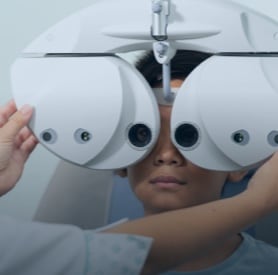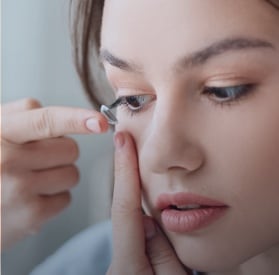Discover a More Vibrant, Colorful World
You might not think of it, but seeing colors is an important part of how we interpret the world around us. If you have color blindness, you might have difficulty distinguishing the difference between certain types of foods, traffic lights, clothes, and more.
We can help you by determining which type of color blindness you may have and offering a range of different lens choices to help you make the most of your vision. Book an appointment with us today and get the help you deserve.
What Is Color Blindness?
Color blindness is the inability to distinguish between 2 or more different types of colors.
Your retina uses 2 different types of cells to detect light, known as rods and cones. Rods detect light and dark tones and are very sensitive to low light levels. Cones recognize different colors, like red, green, and blue.
By combining the information between rods and cones, your brain receives the information you perceive as sight. However, if your cone and rod cells don’t function correctly, it can make it difficult for your brain to distinguish colors, leading to color blindness.


Types of Color Blindness
There are a few different types of color blindness that you can develop. In some cases, people are born with color blindness and may not know they have the issue until later in life.
Issues like disease, eye trauma, and drug use could lead to color blindness later in life. We can determine if you have color blindness using simple color patterns. If we determine you have color blindness, we can prescribe specialty lenses to help make colors more distinguishable and vibrant.
Red-Green Color Blindness
Red-green color blindness is the most common form of color blindness, making it difficult to distinguish between red and green.
There are 4 types of red-green color blindness:
- Deuteranomaly makes greens look more red.
- Protanomaly makes reds look green and less vibrant.
- Protanopia and deuteranopia make reds and greens indistinguishable from each other.
Blue-Yellow Color Blindness
Blue-yellow color blindness is less common, but it can make it difficult to see the difference between blue and green, and yellow and red.
There are 2 types of blue-yellow color blindness:
- Tritanomaly affects the difference between yellow and red and between blue and green.
- Tritanopia makes it difficult to tell the difference between blue and green, purple and red, and yellow and pink.
Monochromacy & Achromatopsia
Monochromacy and achromatopsia are conditions that cause partial or complete color blindness. You may have trouble distinguishing between all types of colors.
See The World For All It’s Worth
It’s never too late to find meaningful ways to make the most of your vision. Book an appointment today and find out how our medical approach can help you see the vibrant world around you more clearly.
Visit Us Today
Want to see what we’re all about?
Find us on the corner of Palm Avenue and Central Avenue.
Our Address
- 4515 Central Avenue Suite 101
- Riverside, CA 92506
Contact Information
- Phone: 951-784-2420
- Fax: 951-784-4713
- Email: [email protected]
Hours of Operation
- Monday: 9:00 AM – 6:00 PM
- Tuesday: 9:00 AM – 6:00 PM
- Wednesday: 8:00 AM – 5:00 PM
- Thursday: 8:00 AM – 5:00 PM
- Friday: 8:00 AM – 5:00 PM
- Saturday: Closed
- Sunday: Closed
Comprehensive Eye Care Services
Our Brands




Our Google Reviews
Be the First to Know,
Be the First to Win.
From eye health insights to exclusive giveaways, your feed just got a lot clearer.







